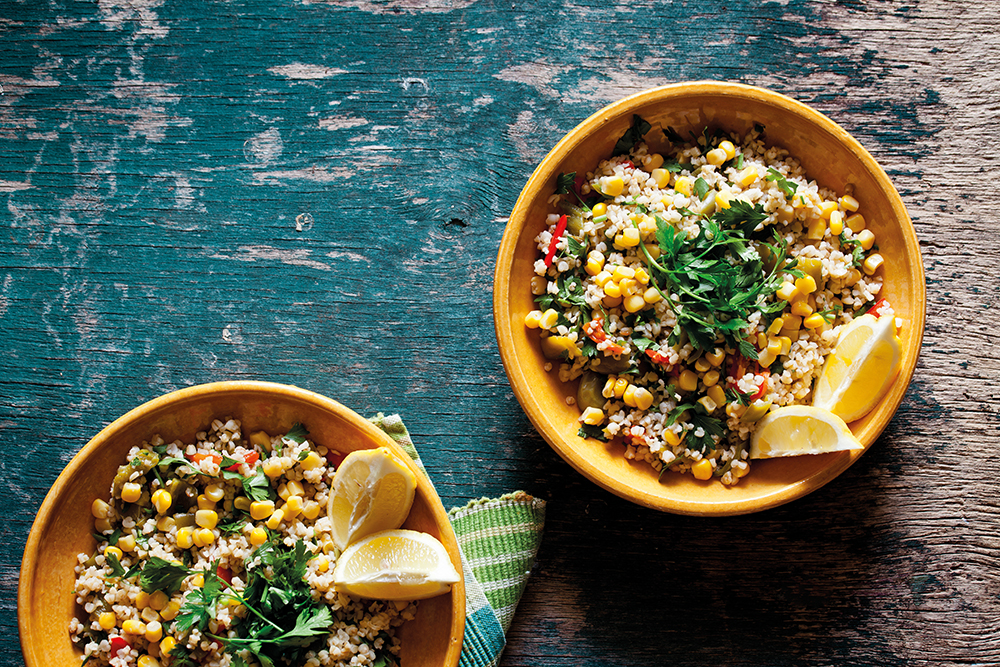Level up your salads to create a triumph of texture, flavour and satisfaction: local chef Alex Rushmer shows you how
Making a salad is a culinary balancing act. Actually, I should rephrase: making a good salad is a culinary balancing act. Making a bad salad is easy, in much the same way that doing anything poorly is easy. But the nimble palate and dexterous fine-tuning required to transform a collection of raw ingredients into a bowl to which you cannot help but return to several times over, requires a base level of knowledge and a not-unreasonable amount of time.
The most significant light bulb moment I had whilst filming Masterchef (almost a decade ago) came when I was working in the kitchen at a Thai restaurant in Stoke Newington. I was given a masterclass in the core principles of Thai cooking, which revolves around the harmonising of four key flavours: sweetness, acidity, heat and saltiness. A couple of years ago, whilst studying for a wine exam, I was introduced to a near identical philosophy with regards to wine making. Key elements – sweetness, acidity, tannin, body – have to be pitched against each other or the wine will taste out of kilter. And so it is with a salad.
A well-executed salad can be a riotous meal all by itself, a pinball of enjoyment, pinging itself around the palate and satisfying to both mind and body. But only if it is a thoughtful, considered composition, and not a hastily thrown together assemblage of languid lettuce, stale croutons and out-of-season tomato.
A well-executed salad can be a riotous meal all by itself
I’ve recently begun to buy into the virtues of a chopped, rather than tossed, salad. A tossed salad – usually involving a leafy base – is fine, but only as a mere side dish. It can rub up alongside a substantial main element in happy harmony, but it can’t hold its own centre stage. A chopped salad, though, is a different story. In the right hands it can bring texture, flavour, satisfaction and satiation in equal measure. Although it can share equal billing with a slice of frittata or a pile of steaming falafel, it is more than happy to have nothing more than more of itself for company.
The recipe for success is simple: the base vegetables form only part of the story but must be robust enough to stand up to being bashed around. I generally begin with a couple of tomatoes and half a cucumber along with whatever else is in the fridge. Once roughly diced, a sprinkle of salt acts like the punchbowl at a social gathering and gets the party well and truly started. A few handfuls of cooked grains make a sensible secondary addition: rice, quinoa, couscous, pearl barley or buckwheat, but plentiful and hearty. Cooked pulses are next: chickpeas, lentils, butterbeans, all are versatile enough to marry the larger flavours that are about to enter the fray in the form of roughly chopped herbs. For me, parsley is an essential but mint, sorrel, lovage or other aromatic soft herbs work equally well. Finally, a texturiser is required. I favour some sort of nut, crushed with the flat of a knife.
Once the key ingredients have been mixed together, the balancing act between richness, sweetness and acidity can begin. Step one: don’t skimp on the oil. Generous glugs of decent olive or rapeseed oil are essential. Cheese also adds a pleasing richness, as well as a poke of acidity if you opt for feta or youthful, zesty goat’s cheese. Further acidity must be added in the form of vinegar, citrus or even pomegranate molasses. Finally, don’t neglect the importance of a little sweetness. Honey, agave syrup or even sugar will add complexity, and help to balance and round out every mouthful. Once everything has been mixed, taste, tweak where necessary (salt, lemon juice, oil and sugar are ideal for this) and, in the words of Lisa Simpson, ‘commence shovelling’.

